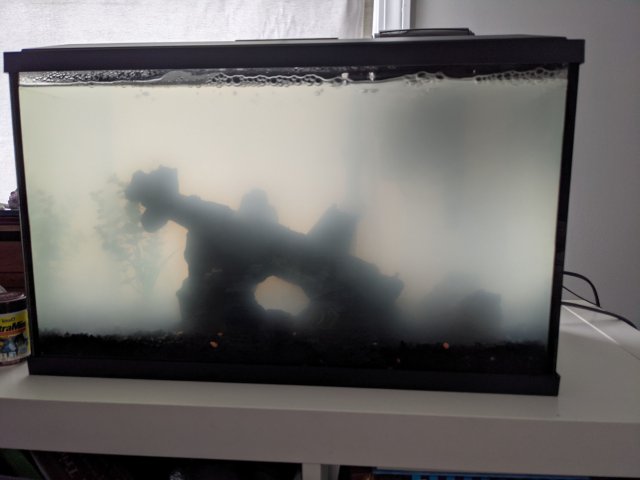You have poured a soup of stuff into your tank and most of it is going more harm than good. For a start, the bacteria in our tanks were identified some years back. The nitrospira does the conversion to nitrite. It used to be thought that nitrobacter did this. However, ammonia and nitrite levels in cycling tanks are considered to be low level. This is most certainly the case in a cycled tank. The other side of this coin is that different strains of the bacteria colonize based on the levels of ammonia and nitrite.
What this means is no matter what bacteria one pours into a tank, when all is said and done what you added may not be there and the needed bacteria are. As the bacteria noyt needed die, they can help to produce the cloudy water.
Next, the bacteria we want in out tanks is a kind that multiplies by dividing. They do not form spores. Look at what is in the products your are addings. Stability contains spores not living bacteria. As for Fritzzime 7 or 9 here is what their site states:
the true nitrifying species of bacteria, Nitrosomonas (NS) and Nitrobacter (NB), which are found in
FritzZyme® 7 and
9.
So why do Stability and Fritzzyme appear to work? I have to do with the way the cycling process progresses. The initial amount of ammonia added in a fishless cycle is somewhat high. Lets assume we are working with 3 ppm on the total ion scale. The ammonia bacteria in Fritzzyme get a big dose of ammonia and go to work right away, this produces a bunch of nitrite. The nitrobacter will handle higher levels of nitrite. So you get the ammonia reading, but you may not see a nitrite one. This is because the bacterial additives, whether they contain nitrobacter or nitrospira, are ready to handle nitrite right away. So you often do not see nitrite in a tank with starter bacteria added. This can be true even when we use bacteria we seed from other tanks.
However, what then happens is the ammonia levels in the tank do not stay high- that is after you add it it goes away faster each time. When fish are added, the ammonia is produced all day long- it might add up to 2 ppm in a day, but there is never ammonia detected. The bacteria handle it as it is produced. But what is happening under the hood is that, as the rate of ammonia creation declines, there is not enough nirite to keep nitrobacter thriving and it pretty much dies off. At the same time the nitrospira are happy as clams with the level if nitrite being made and the nitrospira thrive.
With Stability most of what is in the bottle does not persist over time in terms of nitrifiers. For sure the ones that do anything with ammonia and nitrite are replaced. They are the wrong kind of bacteria.
There is a reason why most bacterial starter products do not contain nitrospira. The methodology for detecting them and the bacteri athemselves have been patented. This was done by Dr. Timothy Hovanec et.al. while he ran the Marineland lab in CA. The patent was shared by Dr. Tim and Marineland. The company was acquired by a conglomerate which also owned Tetra. So the patent was put under Tetra and they created SafeStart. basically both products contain the "proper" bacteria. Dr. H chose not to move to the new company and instead took over the Marineland facility and started his own company.
I would advise you to start over from scratch. I would use either Dr. Tim's or SafeStart (I use the Dr, Tim's when I need such a product and have for years). Go to Dr. Tim's site where he has explicit instructions for doing a fishless cycle with his product. Do not question the directions, do not alter them, just follow them. You should be ready for a full load of fish in 7 -10 days if you do.
https://www.drtimsaquatics.com/resources/library/quick-guide-to-fishless-cycling-with-one-and-only/
One note- Scientist like Dr. H. use the Nitrogen scale to measure ammonia (NH3), nitrite (NO2) and nitrate (NO3). This considers 1 ppm ammonia = 1 ppm nitrite = 1 ppm nitrate. All the nitrogen scale measures is the N. Most hobby kits, including API's us the Total Ion Scale. These count not only the N but also the Os. Think of this like miles and kilometers. Both measure distance and can be converted to each other. The same applies to the Nitrogen and Total Ion Scales.
So when Dr. Tim says to add his ammonium chloride to produce 2 ppm and you test using an API kit you will get a reading of abuut 2.6 ppm. If you want to follow Dr. Tim's directions using kits like those from API, you will need to convert his numbers. Use the following conversion:
For Ammonia multiply his advice by 1.28. Conversely you can divide the API results by 1.28 to turn them into the scale used by Dr. Tim.
For Nitrite multiply his advice by 3.28. Conversely you can divide the API results by 3.28 to turn them into the scale used by Dr. Tim.
Finally, you have two options for dosing ammonia. One is to use Dr. Tim's Ammonium Chloride- this is somewhat pricey but will be easy to use. Or, you can buy pure ammonia, find an online ammonia calculator and dose that way. You can buy the Dr. Tim's products more cheaply on Amazon. You also need to be aware of the fact the heat and freezing kill the bacteria. You never want to see them in 100F type temps. I prefer not to see them get much over the low 90s. for any amount of time. How the bacteria is stored and shipped matters depending on the weather. If they arrive DOA you have no way of knowing they were mishandled until you see they are not working.




